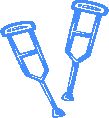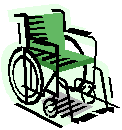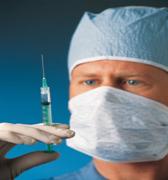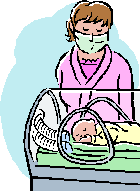DOH Medicaid Update November 2004 Vol.19, No.11
Office of Medicaid Management
DOH Medicaid Update
November 2004 Vol.19, No.11
State of New York
George E. Pataki, Governor
Department of Health
Antonia C. Novello, M.D., M.P.H., Dr. P.H.
Commissioner
Medicaid Update
is a monthly publication of the
New York State Department of Health,
Office of Medicaid Management,
14th Floor, Room 1466,
Corning Tower, Albany,
New York 12237
Table of Contents
eMedNY Phase II: Dental Change in Oral Cavity Reporting
Patient Information: How to Reduce Fats
eMedNY Phase II: Companion Guides
eMedNY Phase II: Magnetic Media Submissions
Ambulette Transportation Providers Additional Information Required For Billing
Prior Approval Requests for Downstate Providers: Address Change
Reimbursement Policy for Physician-Administered Drugs
Coverage for Wireless Capsule Endoscopy
Sterilization and Hysterectomy Consent Form Request
HIPAA Deadline Exception: December 29, 2004
Coverage of Palivizumab (Synagis®)
Billing Reminder: Physicians, Physicians Assistants, Group Practitioners
Great American Smokeout November 18, 2004
eMedNY
Update
All Providers
Changes Affecting Prior Approvals/Prior Authorizations
Return to Table of Contents
eMedNY Phase II (anticipated in March 2005) will introduce changes that impact the submission of prior approval/prior authorization requests and the responses to those requests:
- Electronic prior approval/prior authorization requests and responses will be allowed only on the HIPAA 278 transaction. The Companion Guides for the HIPAA 278, available on the www.nyhipaadesk.com website, have been updated accordingly. The MMIS Legacy electronic Prior Approval/Prior Authorization format will be discontinued.
- Paper prior approval/prior authorization request forms have been modified to comply with eMedNY requirements. Samples of the new forms are available at the eMedNY website: www.emedny.org. The layout and completion of the new forms will be discussed in training sessions, which will be offered by CSC in the near future.
- The prior approval/prior authorization number format will change from 8 digits to 11 digits. After the eMedNY Phase II implementation, providers will be allowed to continue using Legacy prior approvals/prior authorizations (8-digit numbers) until they expire or the units are exhausted. When using a Legacy prior approval/prior authorization in claim submissions (both electronic and paper) to eMedNY, providers will be required to add three zeroes in front of the prior approval/authorization number to comply with the 11-digit eMedNY requirement.
- Prior Authorizations for non-emergency transportation for New York City recipients will continue to be issued over the CSC Prior Authorization line for providers who choose that request method.
For questions regarding this article, please call Computer Sciences Corporation at (800) 522-5518 or (518) 447-9860.
eMedNY
Update
Dental Providers
Dental Claims HIPAA 837D Transaction
Change in Oral Cavity Reporting
Return to Table of Contents
The implementation of eMedNY Phase II (anticipated in March 2005) will require a change in the reporting of ORAL CAVITY designations in the HIPAA 837 Dental (837D) transaction, as explained below.
Issue
Currently, Medicaid recognizes two ORAL CAVITY designations, which do not have a mapping in the HIPAA 837D:
- Upper Anterior Sextant; and,
- Lower Anterior Sextant.
The instructions given in the Companion Guides to report these two designations are to enter:
- Oral Cavity Code 09 (Other Area of Oral Cavity) in Loop 2400, Segment SV304; and,
- A Tooth Code (06 - 11 for the Upper Anterior Sextant and 22 -27 for the Lower Anterior Sextant) in Segment TOO02.
eMedNY will not recognize the two Oral Cavity designations indicated above. These specific instructions will be nullified as of Phase II implementation!
Solution
Only the Oral Cavity values and definitions listed in the HIPAA Implementation Guides will be recognized and accepted as valid.
The Companion Guides for the 837D, which can be found at www.nyhipaadesk.com, will be updated accordingly.
For questions regarding this matter, please call Computer Sciences Corporation at (800) 522-5518.

PATIENT EDUCATIONAL TOOLS
Return to Table of Contents
This month's patient educational tools features an article on
How to Reduce Unhealthy Fats
The Medicaid program encourages practitioners to copy and distribute the following information to their patients and to share it with their colleagues.
HOW CAN I REDUCE UNHEALTHY FAT FROM MY DIET?
Eating too much saturated fat increases the risk for heart disease.
- A diet high in fat causes the body to make more cholesterol.
- This cholesterol builds up in the arteries and could lead to a heart attack.
- Too much fat also causes an increase in calories which increases the chance of becoming obese (another risk factor for heart disease and some types of cancer).
Some Tips To Help Reduce The Fat In Your Diet
- Use semi-skim or skim milk instead of whole milk.

- Switch to a low fat spread without hydrogenated oils, instead of butter or margarine.
- Eat more chicken and fish, and less red or fatty meats.
- Choose lean cuts of meat and trim off all excess fat.
- Grill, bake, steam or microwave food rather than frying it.
- Try low-fat varieties of dairy products such as cheese and yogurt.

- Choose polyunsaturated cooking oil or monounsaturated olive oil.
- Avoid high-fat snacks, such as crisps, biscuits, cakes and pastries.
- Eat foods that are naturally low in fat-- like whole grains, fruits and vegetables.
- Eat a lot of fiber such as oats, bran, peas, beans, cereal and rice.
- Limit your consumption of fried and processed foods and commercially prepared baked goods such as donuts, cookies and crackers.

- Limit animal products like egg yolks, cheeses, whole milk, cream, ice cream and fatty meats, and avoid large portions.
- Check food labels especially for the level of saturated fat. Avoid or limit foods high in saturated fat.
- Check the food label for hydrogenated or partially hydrogenated oils - these foods are high in saturated and trans-fatty acids and should be avoided.


How Much Fat Should I Eat?
The current recommendation is that we eat no more than 33% of our calories from fat.
- Saturated fat should only account for 10%
- Polyunsaturated and monounsaturated fat should only account for 23%.
With a 2,000 calorie diet you would eat 73 grams of fat!
With a 1,500 calorie diet, you would eat 55 grams of fat!
| TYPES OF FAT | MAIN SOURCE | APPEARANCE AT ROOM TEMPERATURE |
MONOUNSATURATED Lowers LDL ( bad cholesterol) |
Olives, olive oil, canola oil, peanut oil, cashews, almonds, peanuts and most other nuts, avocados, etc. |
Liquid  |
POLYUNSATURATED | Corn, soybean, safflower, sesame, sunflower and cottonseed oils, fish, sesame and sunflower seeds, walnuts, etc. | Liquid  |
SATURATED Raises both LDL and HDL | Whole milk, butter, cheese, ice cream, red meat, chocolate, coconuts, coconut milk, coconut and palm oil, brazil and macadamia nuts, pistachios, poultry, etc. | Solid  |
TRANS Raises LDL | Most margarines, vegetable shortening, partially hydrogenated vegetable oil, deep fried chips, most fast foods, most commercial baked goods, most dry packaged foods and instant mixes. | Solid or semi-solid  |
Source: Medline Plus Medical Encyclopedia: Fat www.nlm.nih.gov/medlineplus/ency/article/002468.htm
Nutrition Source, Harvard School of Public Health, www.hsph.harvard.edu/nutritionsource/fats.html
Prepared by the NYSDOH, Office of Medicaid Management, Bureau of Program Guidance 10/04
eMedNY
Update
All Providers
HIPAA COMPANION GUIDES FOR
EMEDNY PHASE II
Return to Table of Contents
New HIPAA Companion Guides for the transactions listed below have been made available to reflect changes required by the eMedNY Phase II system. The changes will be effective upon implementation of eMedNY Phase II.

Please consult the updated Companion Guides, which are available at the www.nyhipaadesk.com website, to ensure that you are ready for the implementation of eMedNY Phase II, scheduled for March 2005.
Failure to make the necessary updates to your system could impact your Medicaid payments.
Updated Companion Guides
270/271 Eligibility Benefit Inquiry and Response
276/277 Claim Status Request Inquiry and Response
278 Request for Review and Response (Service Authorization [SA])
278 Request for Review and Response (Prior Approval/Prior Authorization [PA])
820 Payroll Deducted and Other Group Premium Payment for Insurance Products
835 Claim Payment Advice
837 Dental
837 Institutional
837 Professional
For questions regarding this matter, please call Computer Sciences Corporation at (800) 522-5518 or (518) 447-9860.
eMedNY
Update
All Providers
MAGNETIC MEDIA
Tape, Diskette and Cartridge Submissions
Return to Table of Contents
Physical media such as tape, diskette, and cartridge will not be supported by eMedNY Phase II as of implementation date (anticipated in March 2005).
Trading partners who currently use this type of media for claim submission will need to migrate to CPU-to-CPU, FTP, or eMedNY Exchange, and will need to obtain user IDs and passwords.
As with the inbound submissions, physical media (tape and cartridge) will no longer be used to produce remittance advices.
Individual providers and managed care plans who choose to receive the HIPAA 835 or the 820 transactions will receive these as electronic transmissions.
Providers and managed care plans will still have the choice of receiving paper remittance advices instead of the 835 or 820 transactions.
For questions regarding this matter, please call Computer Sciences Corporation at (800) 522-5518 or (518) 447-9860.
This article was printed in the July 2004 Medicaid Update. In that article the billing instructions, for those submitting the HIPAA 837P transaction, were wrong.
This article is printed in its entirety, with correct instructions for the submission of the HIPAA 837P.
AMBULETTE TRANSPORTATION PROVIDERS
ADDITIONAL INFORMATION REQUIRED FOR BILLING
Return to Table of Contents

Transportation providers billing for ambulette services (category of service 0602) are now required to:
- Include the driver license number of the individual driving the vehicle on their claim.
- Include the license plate number of the vehicle used to transport the Medicaid client on their claim.
Providers should diligently update their billing systems to comply with this requirement.
Billing instructions for paper and proprietary electronic submissions (Claim Form A):
- The first eight digits of the individual's driver license number should be entered in the "Other referring/ordering provider ID/license number" field (Field 37).
- The remaining digit(s) of the driver license number should be entered in the "Other referring/ordering provider type" field (Field 38) beginning in the first position of this two-digit field.
- The vehicle license plate number should be entered in the "Service provider ID/license number" field (FIELD 31).
- The "Service provider type" field (Field 32) should be left blank.
Billing instructions for HIPAA 837P transactions:
Driver's License - Referring Provider Loop 2310A at the claim level or Loop 2420F must be completed. This includes the NM1 segment. The employer tax identification number should be submitted in data element NM109. The individual driver's license number should be reported in the referring provider secondary identification REF segment using qualifier 0B - state license number in REF01 and the license number in REF02.
Vehicle Plate Number - Rendering Provider Loop 2310B at the claim level or Loop 2420A must be completed. This includes the NM1 segment. The employer tax identification number should be submitted in data element NM109. The vehicle plate number should be reported in the referring provider secondary identification REF segment using qualifier G2 - provider commercial number in REF01 and the vehicle plate number in REF02.
- Emergency transportation (ambulance) should use codes 41 (land) or 42 (air or water) in CLM05-1. Non-emergency transportation should report code 99 (other unlisted facility) in CLM05-1.
Note: Under eMedNY Phase II, the billing instructions for the 837P transaction will apply to all transportation claims.
Questions regarding these instructions can be addressed to CSC's Provider Services staff by calling (800) 522-5518 or (518) 447-9860.
Attention
Downstate DME
Providers
Durable Medical Equipment
Prior Approval Requests
Address Change
Return to Table of Contents


Beginning Monday, November 1, 2004, the Metropolitan Regional Office, located at 5 Penn Plaza, New York City, will no longer process Medicaid prior approval requests.
All prior approval requests previously sent to that office should be sent to the following address:
Office of Medicaid Management
Bureau of Medical Review and Payment
150 Broadway, Suite 6E
Albany, NY 12204-2736
The Medical Prior Approval Unit can be reached at (800) 342-3005 or (518) 474-3575.
Return to Table of Contents
Fraud impacts all taxpayers.
Do you suspect that a recipient or a provider has engaged in fraudulent activities?
Please call:
1-877-87FRAUD
Your call will remain confidential.
Reimbursement for Physician-Administered Drugs
PHYSICIAN, NURSE PRACTITIONER AND
CHEMOTHERAPY CLINIC
Return to Table of Contents

Physicians and Nurse Practitioners
This article is intended to summarize a policy that is currently in effect regarding reimbursement for physician-administered ('J,' 'S,' and 'Q' code) drugs. For all procedure codes that start with the letter 'J,' 'S' or 'Q' and appear in the Physician Services or Nurse Practitioner provider manuals, the appropriate procedure is as follows:
- The physician/nurse practitioner must purchase the drug;
- The physician/nurse practitioner administers the drug to the Medicaid patient; and,
- The physician/nurse practitioner bills Medicaid for the drug at his/her actual acquisition cost.
Since physician-administered drugs typically require special care, storage and handling by a medical professional, it is not appropriate for the physician to write a prescription for the patient to get these drugs at a community pharmacy.
Medicaid reimbursement to a physician for 'J,' 'S' or 'Q' code drugs is the amount of the physician's actual acquisition cost.
Some of these drugs are 'By Report.' The instructions for billing 'By Report' codes appear in the Procedure Code section of the MMIS Physician Provider Manual on page 7-2 (#7.) and on Page 7-1 of the MMIS Nurse Practitioner Provider Manual (Rev. 7/1/03).
Since the Fee Schedules in the Physician/Nurse Practitioner provider manuals were last updated 7/1/03, drugs with FDA approval since that time may not be listed. These drugs, when provided for an FDA-approved use, may be billed using the most appropriate unlisted code:
- J9999, Not otherwise classified antineoplastic drugs; or,
- 90799, Unlisted therapeutic, prophylactic or diagnostic injection (injectable material).
As new 'J,' 'S', and 'Q' codes are added to the Medicaid reimbursement file, they are announced in the Medicaid Update. Most recent additions appear in the October 2004 issue and may be accessed on the internet at http://www.health.state.ny.us/health_care/medicaid/program/2004/oct2004.htm#code.
There have been numerous inquiries regarding reimbursement for physician-administered drugs when Medicare is the primary payer. Most physician-administered drugs will be reimbursed at the full coinsurance. Please refer to the May 2004 Medicaid Update article entitled "Physician Billing for Drugs" at http://www.health.state.ny.us/health_care/medicaid/program/2004/may2004.htm#drugs
Chemotherapy Clinics and Ordered Ambulatory
Clinics enrolled with category of service 0160 or 0287 that have rate code 3092 (Chemo Clinic Service) may bill their per visit clinic rate, and may bill separately for the drugs administered under their Ordered Ambulatory category of service (0163 or 0282). Reimbursement for the drugs is the clinic's actual acquisition cost.
Questions regarding "By Report" items should be directed to the Bureau of Medical Review and Payment at (518) 474-8161
Other questions should be directed to the Bureau of Policy Development & Agency Relations at (518) 473-2160.
Attention
Physicians
Clinics
Ordered Ambulatory Providers
MEDICAID COVERAGE FOR
WIRELESS CAPSULE ENDOSCOPY
Return to Table of Contents
Effective for dates of service on or after October 1, 2004, wireless capsule endoscopy is Medicaid reimbursable, with the following limitations:
- Wireless capsule endoscopy is not payable for patients who have not undergone upper GI (gastrointestinal) endoscopy and colonoscopy within the same spell of illness, which have failed to reveal a source of bleeding.
- This test is payable only for those beneficiaries with documented continuing GI blood loss and anemia secondary to bleeding.
- This test is not reimbursable for colorectal cancer screening.
- The test is payable only for services using FDA (Food and Drug Administration) approved devices.
- This test is not reimbursable for the confirmation of lesions or pathology normally within the reach of upper or lower endoscopes (lesions proximal to the ligament of Treitz or distal to the ileum).
- This test is not payable for patients with hematemesis (ICD-9 578.0).
- This test is covered only when performed by a gastroenterologist.
- It is expected that the test will be performed only once during any episode of illness.
- Ingestion of the capsule does not constitute an Evaluation and Management (E &M) service billing.
Only these 6 ICD-9 diagnosis codes support medical necessity:

562.02 Diverticulosis of small intestine with hemorrhage
562.03 Diverticulitis of small intestine with hemorrhage
569.85 Angiodysplasia of intestine with hemorrhage
578.1 Blood in stool
578.9 Hemorrhage of gastrointestinal tract, unspecified
792.1 Nonspecific abnormal findings in stool contents
PHYSICIANS/ORDERED AMBULATORY PROVIDERS
In a physician's office or as an ordered ambulatory procedure, capsule endoscopy can be billed as described below:
| Procedure Code | Procedure Description | Procedure Component | Maximum Fee |
| 91110 | Gastrointestinal tract imaging, intraluminal (e.g., capsule endoscopy), esophagus through ileum |
Global | $800 |
| 9111026 | Professional | $320 | |
| 91110TC | Technical | $480 |
NOTE: Physicians may bill for the global fee or the professional fee. A physician may not bill solely for the technical component.
CLINICS
For clinic patients (other than ordered ambulatory), payment would be considered included in the clinic threshold rate.
Questions regarding this article should be directed to the Bureau of Policy Development & Agency Relations at (518) 473-2160.
How Do I Request
Sterilization and Hysterectomy Consent Forms
Return to Table of Contents

Physicians, nurse practitioners and licensed midwives may request sterilization and hysterectomy consent forms by submitting a written request.
- 1. Write the request on the form below.
- 2. Tear this page out of your Update.
- 3. Mail or fax the request to the address/fax number listed on the request form.
FORM NUMBER FORM TITLE
LDSS-3113 Acknowledgement of Receipt of Hysterectomy Information (English)
LDSS-3113S Acknowledgement of Receipt of Hysterectomy Information (Spanish)
LDSS-3134 Sterilization Consent Form (English)
LDSS-3134S Sterilization Consent Form (Spanish)
_______________________________________________________________________________
| REQUEST FOR FORMS OR PUBLICATIONS | |
Submit Request to: New York State Department of Health
| Deliver Supply to: (Complete Address) |
| FORM NUMBER | FORM TITLE | QUANTITY REQUESTED |
| Signature of Person Submitting Request: |
Phone Number |
Fax Number |
Date Submitted |

DEADLINE FOR END OF
HIPAA EXCEPTION PROCESSING
DECEMBER 29, 2004
Return to Table of Contents
Last month, the Department announced an exception processing program for Medicaid trading partners who were unable to meet the October 6 HIPAA compliance date. If you have not yet become HIPAA compliant, and have not yet applied for the exception processing program, you may still do so by completing an application outlining your proposed steps for achieving compliance.
Complete information on the program, including the application and instructions, is available at www.nyhipaadesk.com, or you may contact the Computer Sciences Corporation (CSC) HIPAA Help line at (800) 522-5518. You must be aware, however, that the exception processing program will end on December 29, 2004.
After the December 29, 2004 deadline, Medicaid will accept and process only electronic transactions and claims submitted in a HIPAA-compliant format.
Electronic transactions and claims submitted in a non-HIPAA compliant format will be rejected.
Please note that the December 29, 2004 deadline applies only to electronic transactions and claims submitted to Medicaid. It does not apply to outbound transactions (835, 820) or paper claims submissions.
With the end of exception processing only a month away, providers must take all necessary steps to become HIPAA-compliant and avoid any disruption in claims processing and payment flow.
Please remember that providers are ultimately responsible for claims submitted to Medicaid, whether by them directly or by another entity on their behalf.
CSC and the Department have developed extensive resources to expedite your HIPAA compliance efforts, which are available at the www.nyhipaadesk.com and http://www.emedny.org websites.
The Department is committed to working with you to achieve HIPAA compliance.
If you have any questions relative to Medicaid's HIPAA requirements or need technical clarification, please contact the CSC HIPAA Support Help line at (800) 522-5518.
Would You Like Future Medicaid Updates Emailed To You?
You will receive the Update about 3 weeks before the mailed copy!
Email your request, along with your provider identification number (found on the mailing address label of the update) to: MedicaidUpdate@health.state.ny.us
Let us know if you want to continue receiving the hard copy in the mail, in addition to the emailed copy.

Medicaid Coverage of Palivizumab (Synagis®)
For Children at Risk for Respiratory Syncytial Virus Infections
Return to Table of Contents
Palivizumab is an intramuscular injection used in certain high-risk children, especially those with histories of prematurity and chronic lung disease (CLD) (formerly designated as bronchopulmonary dysplasia) as prophylaxis for respiratory syncytial virus (RSV). RSV is a leading cause of bronchiolitis and pneumonia in infants. The RSV season typically starts in November and lasts through April. Palivizumab injections should be initiated at the start of, and then administered monthly, throughout the RSV season.

GUIDELINES
Following are guidelines for identifying children who should be considered for RSV prophylaxis adapted from the American Academy of Pediatrics' Policy Statement1:
- Infants and children less than 24 months of age with CLD who have required medical therapy for CLD within the past 6 months before the anticipated start of the RSV season.
- Neonates born at greater than 28 weeks and less than 32 weeks gestation with or without CLD who are less than 6 months of age at the start of the RSV season.
- Neonates born at 28 weeks of gestation or less with or without CLD and who are less than 12 months of age at the start of the RSV season.
- Neonates born between 32 and 35 weeks gestation with or without CLD who are less than 6 months of age at the start of the RSV season only if two or more additional risk factors are present including: school-age siblings, child-care attendance, exposure to environmental air pollutants, congenital abnormalities of the airways or severe neuromuscular disease.
- Children who are 24 months of age or younger with hemodynamically significant cyanotic and acyanotic congenital heart disease.
Palivizumab should not be used for the treatment of RSV disease.
REIMBURSEMENT AND PAYMENT
Medicaid reimburses for palivizumab when billed by Medicaid-enrolled physicians, nurse practitioners and pharmacy providers.
Practitioner Billing
Physicians and nurse practitioners should use code 90749 (unlisted immunization procedure), with a copy of the invoice attached to the claim, when billing the cost and administration of Palivizumab. Describe the product name and total dose administered on the claim form, and insert the acquisition cost plus a two-dollar ($2.00) administration fee in the "amount charged" field. For more information on practitioner billing, see the Physician MMIS Manual page 7-105 (7/1/03).
Pharmacy Billing
Pharmacy providers should enter the Palivizumab NDC number into the on-line billing system as they would for any prescription pharmaceutical.
For further information on Medicaid coverage guidelines of Palivizumab, please contact staff in the Division of Policy and Program Guidance.
Physician providers: (518) 473-2160
Pharmacy providers: (518) 486-3209
For billing questions, please contact CSC at (800) 343-9000.
References:
- American Academy of Pediatrics, Committee on Infectious Diseases and Committee on Fetus and Newborn. Policy statement: revised indications for the use of palivizumab and respiratory syncytial virus immune globulin intravenous for the prevention of respiratory syncytial virus infections. http://www.aap.org/policy/rsvpolicy.pdf
- American Academy of Pediatrics, Committee on Infectious Diseases and Committee on Fetus and Newborn. Prevention of respiratory syncytial virus infections: indication for the use of palivizumab and update on the use of RSV-IGIV. Pediatrics.1998;102:1211-1216.
- Meissner HC, et al. Prevention of RSV infection in high risk infants: Consensus opinion on the role of immunoprophylaxis with palivizumab, a humanized respiratory syncytial virus monoclonal antibody for prevention of respiratory syncytial virus infection in high risk infants. Pediatr Infect Dis J. 1999;18 (3):223-231.
- Synagis® (palivizumab) prescribing information. Medimmune, Inc., Rev. Date Sept. 14, 2003.
(Rev. 9/04)
Attention
Physicians
Physician Assistants
Group Practitioners
PHYSICIAN ASSISTANTS
RENDERING PROVIDER ONLY
Return to Table of Contents
Physician Assistants are not allowed to bill Medicaid directly. For the correct adjudication and payment of claims, the correct provider identification (ID) number to bill for Medicaid services must be submitted.
- Physician Assistants must submit either their Medicaid ID number or their license number as the Rendering Provider.
- When a Medicaid ID number is used to identify the Physician Assistant, you must also submit the Supervising Physician's Medicaid ID number and Location Number as the Supervising Provider (in most instances, the billing Provider ID number will also be entered as the Supervising Physician).
Medicaid will deny all claims when:
- The Physician Assistant is reported as the billing provider; or
- When the Physician Assistant's Medicaid ID number is entered as the Rendering Provider, but no Supervising Physician is entered.
For questions regarding this article, please call Computer Sciences Corporation at (800) 522-5518 or (518) 447-9860.

The Great American Smokeout®
November 18, 2004
Return to Table of Contents
It's never too early to think about "kicking the habit"!
The American Cancer Society's volunteers and staff hold the Great American Smokeout® every year to help smokers quit tobacco use for at least one day.
More people quit smoking on this day than any other day of the year!
Health care professionals have the ability to help patients stop tobacco usage.
The Great American Smokeout® is an opportunity for Americans to renew their commitment to a tobacco-free environment for themselves and family members.
Smoking is an addiction and health care professionals can be very influential when they suggest smoking cessation to their patients.
Please take time to mention this event as the first day towards a healthier lifestyle.
Encourage your patients to take part in the Great American Smokeout® on November 18, 2004.
The Medicaid program is committed to assisting all Medicaid recipients who would like to stop tobacco use.
Medicaid covers both prescription and over-the-counter smoking cessation agents.
For more information on Medicaid's Smoking Cessation policy, contact (518) 474-9219.

For more information on tobacco cessation contact:
NYS Smokers Quitline: (866) 697-8487
American Cancer Society: (800) 227-2345
American Lung Association: (800) 586-4872

PROVIDER SERVICES
Return to Table of Contents
Missing Issues?
The Medicaid Update, now indexed by subject area, can be accessed online at the New York State Department of Health website:
http://www.health.state.ny.us/health_care/medicaid/program/main.htm
Hard copies can be obtained upon request by calling (518) 474-9219.
Would You Like Future Updates Emailed To You?
Email your request to our mailbox, MedicaidUpdate@health.state.ny.us
Let us know if you want to continue receiving the hard copy in the mail in addition to the emailed copy.
Do You Suspect Fraud?
If you suspect that a recipient or a provider has engaged in fraudulent activities, please call the fraud hotline at: 1-877-87FRAUD. Your call will remain confidential.
As a Pharmacist, Where Can I Access the List of Medicaid Reimbursable Drugs?
The list of Medicaid reimbursable drugs is available at: http://www.eMedNY.org/info/formfile.html
Questions About an Article?
For your convenience each article contains a contact number for further information, questions or comments.
Do You Want Information On Patient Educational Tools and Medicaid's Disease Management Initiatives?
Contact Department staff at (518) 474-9219.
Questions About HIPAA?
Please contact the HIPAA Support Helpline at (800) 522-5518 or (518) 447-9860.
Address Change?
Please contact the Bureau of Medical Review and Payment at:
Fee-for-Service Provider Enrollment Unit, (518) 486-9440
Rate Based Provider Unit, (518) 474-8161
Billing Question? Call Computer Sciences Corporation:
Provider Services (800) 522-5518 or (518) 447-9860.
Comments and Suggestions Regarding This Publication?
Please contact the editor, Timothy Perry-Coon at MedicaidUpdate@health.state.ny.us or via telephone at (518) 474-9219 with your concerns.
The Medicaid Update: Your Window Into The Medicaid Program
The State Department of Health welcomes your comments or suggestions regarding the Medicaid Update.
Please send suggestions to the editor, Timothy Perry-Coon:
NYS Department of Health
Office of Medicaid Management
Bureau of Program Guidance
99 Washington Ave., Suite 720
Albany, NY 12210
(e-mail MedicaidUpdate@health.state.ny.us)
The Medicaid Update, along with past issues of the Medicaid Update, can be accessed online at the New York State Department of Health web site: http://www.health.state.ny.us/health_care/medicaid/program/main.htm